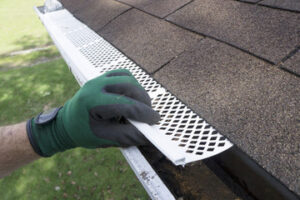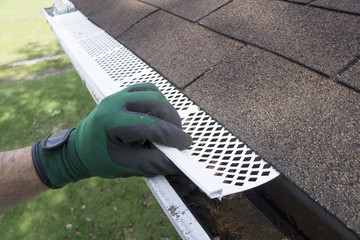Gutter systems play a critical role in how your home functions. They shed rainwater, prevent clogs, and protect the foundation and landscaping from damage.
However, gutter installation is not an easy task to undertake. External elements like weather conditions can significantly impact the timeline of this extensive project. Open communication is key for navigating these variables efficiently. Contact Gutter installation Gainesville FL for professional help.
A gutter system safeguards a home from water damage by channeling rainwater away from the building, preventing stagnation that leads to leaks or reflux of water into the structure. Gutter installation is an important aspect of home maintenance and should be performed by experts. Hiring professionals to perform this job will not only ensure a smooth and successful process but also save you money in the long run. This is because gutters are not something you can afford to make mistakes with.
Gutter installers are trained to know how to handle various aspects of the job, including accurate measurements and preparing materials. They also have the expertise needed to determine what size gutters are best for a particular roof, and they will be able to work around difficult areas of the home’s structure. This will allow them to provide you with a complete and effective gutter system that’s sure to protect your house from water damage and last into the future.
Before installing new gutters, a professional will assess the existing ones to see if there are any signs of wear and tear. This is crucial because old gutters may have rotten boards and fascia that need to be replaced. It’s also necessary to check the downspouts, as these need to be properly positioned in order to channel water away from the foundations of the house.
Rain gutters should be installed according to a specific design, depending on the roof type and local weather conditions. It’s also important to choose a color and style that suits the exterior of your home. The right gutter system will complement the overall aesthetics of your home and add to its curb appeal.
The benefits of gutter installation are undeniable, especially in the Tri-State area, where homeowners can benefit from robust protection against the elements. Gutter installation reduces the need for expensive repairs, cuts down on emergency leak situations, and safeguards a home’s foundation, longevity, and value. Moreover, the addition of new gutters improves curb appeal and can be an attractive selling point for your property.
Timeline
Gutter systems can help protect the fascia of your home from rotting. They also prevent staining on your home’s walls from water splashback. This splashback contains grass, dirt, minerals and other debris that can build up and stain your home’s walls. Gutters can also redirect water from the foundation of your home, preventing damage to landscaping and the structure of your home. When choosing gutters, consider a contractor that offers custom options and quality materials to ensure the system will be durable.
Home size and the complexity of the roof design play a key role in determining how long it will take to install new gutters. The number of gutters required and the inclusion of additional features like downspouts or gutter guards can significantly influence the timeline as well. Depending on these factors, a gutter replacement project may take anywhere from a few hours to a day or more.
A reputable gutter contractor will communicate clearly with homeowners about the project’s timeline and expected outcomes. They will also provide an estimate of the cost before beginning work. They should offer a clear breakdown of all costs, including any fees for permits or extra services.
While the installation process will depend on a variety of factors, experts recommend scheduling a gutter replacement in spring. This allows homeowners to enjoy the benefits of their new gutter system before summer rainy season arrives. It’s also the best time to inspect the gutter system and address any underlying issues.
In addition to the size of your home and the type of gutters, the condition of your existing gutters and weather conditions can affect the overall timeline for the project. Unexpected challenges can delay the project or even cause it to be halted completely, so homeowners should be prepared for this. When interviewing contractors, ask about their experience with handling unexpected issues and how they will handle any delays or additional costs that may arise during the project. A reputable contractor will be transparent with their estimated timelines and their process for managing unexpected changes. This will give homeowners peace of mind that their project will be completed in a timely manner.
Weather
Gutter installation is a complex process with a lot of moving parts, and many factors can impact it. Weather conditions, for example, affect everything from timing to materials and even the type of gutters you choose. Understanding these influences will help you plan and execute a successful project that will last for years to come.
Winter weather can pose unique challenges for gutters, resulting in damage and leaks. In addition, winter temperatures can make it difficult for installers to handle the cold, affecting the quality of materials and increasing the risk of accidents. Fortunately, there are ways to mitigate the impact of Bronx weather on gutters during installation and maintenance.
Choosing Durable Gutter Materials
Gutter materials like aluminum and steel are highly resistant to harsh weather conditions, including cold, snow, ice, and high winds. Choosing durable gutter materials will ensure that your new gutters will last for years to come.
Installing Gutter Guards
Gutter guards can significantly reduce the amount of debris that enters gutter systems, reducing clogs and overflow. Gutter guards can also help improve water flow by directing rainwater away from your home’s foundation.
Regularly Checking for Damage
Regular inspections of your gutter system can help identify problems before they cause serious damage. For example, a damaged fascia board can compromise the structural integrity of your gutters, leading to leakage or flooding. Inspecting your gutters for loose components can prevent these issues, and addressing them promptly will save you time and money in the long run.
Keeping a Clean Work Area
When installing gutters, it is important to keep the workspace and roof free of ice and snow. This will protect workers from accidents and ensure that the material is handled correctly to avoid breakage. In addition, using insulated tools and having a heated workspace can improve the efficiency of the installation process.
Lastly, it is essential to regularly inspect your gutters after stormy weather to identify any damage or clogs. For example, a storm can blow leaves, twigs, and branches into gutters, causing them to overflow and cause water damage. Inspecting gutters for signs of discoloration, cracks, or warping can help you address any problems quickly before they escalate.
Safety
Gutter installation is a high-risk project that involves working at heights and using various tools. As such, it requires a meticulous approach to ensure safety and the proper execution of all installation steps. This is essential in averting accidents and guaranteeing an efficient gutter system that protects your home from water damage.
The first step in the process is preparing your materials and making sure that you have all the necessary tools before you start. This includes a ladder that is tall enough for the task and a pair of sturdy work gloves. It is also important to have a spotter who can help you in case of any problems while installing the gutters. It is advisable to schedule the installation on a day that is clear and calm to avoid unforeseen weather conditions that could interfere with your progress.
After measuring the length of your roof edge, you can mark and cut the gutter sections to size. It is a good idea to add a little extra length to accommodate miter joints in the corners. You should then slide the gutters into place and secure them securely. Make sure that they slope slightly downward to direct the rainwater away from your foundation and house. The final step is to install the downspouts, which should be positioned at the lowest points of your gutter system. Ensure that they are tightly fixed to prevent them from falling down or becoming clogged with debris.
Cleaning your gutters on a regular basis is the best way to ensure that they function properly and are free from clogs. This will also help to avoid future repairs and maintenance costs. A gutter that is full of leaves and other debris can overflow and cause structural damage to your home. In addition, overflowing gutters can cause soil erosion and weed growth.
A well-designed gutter system can greatly enhance your home’s curb appeal and increase its value. A professional gutter installer can guide you in choosing the best type and style to suit your needs. In addition, he can help you choose the best material for your roof and local climate to achieve optimal performance.
